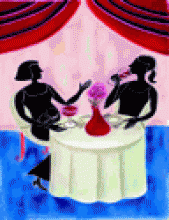Background and epidemiology: North Americans interviewed in January about their past month's alcohol consumption are much more likely to report drinking behaviour at this time than at other times of the year.1 This pattern, revealed by telephone survey data collected by the US Centers for Disease Control and Prevention, has been coined the “January effect” — the confessional consequence of overindulgence in the holiday season and a new year's resolution toward temperance.
The relation between aggregate levels of alcohol consumption and alcohol problems is direct. According to a recent time-series analysis of annual mortality rates (1950–1998) in relation to alcoholic consumption in Canada, an increase in per capital alcohol consumption of 1 L was accompanied by an increase in accidental mortality of 5.9 among males and 1.9 among females per 100 000 population.2 Accidental death is merely the visible tip of an insidious iceberg. Absenteeism, gastrointestinal upset and physical aggression3 are a few of the many harms of alcohol intoxication not marked by vital statistics and police reports.
Clinical management: In Canada and the United States physicians are advised to screen all patients routinely and to intervene with those drinking at risky or problem levels.4,5 These recommendations are based on findings from several randomized clinical trials that showed the efficacy of brief interventions for people reporting heavy consumption patterns or problems related to their drinking but who were not alcohol dependent.
Despite these recommendations, it is apparent that family physicians are not asking their patients enough about their drinking or advising appropriate patients to cut down or quit. A secondary analysis of the 1993 Ontario Alcohol and Other Drug Opinion Survey revealed that the majority of the 941 respondents felt that general practitioners should routinely ask patients about their drinking (79%) and that they should advise regular drinkers to cut down (94%).6 Yet only 23% of the respondents recalled being asked by their family doctor about their use of alcohol, and only a small proportion of at-risk (5%) and problem drinkers (15%) in the study reported having been advised by their doctor to reduce their consumption. The authors concluded that physicians should be informed of the high public acceptance of physician screening and intervention for risky alcohol use.
Asking patients whether they are concerned about their drinking and reviewing the low-risk drinking guidelines (Box 1) is a start and may be enough.
Prevention: Determinants of alcohol use and abuse are multifactorial and complex and include genetic predisposition, age at first drink and the community culture and context. Many of the challenges posed by the problem of preventing alcohol abuse and addiction parallel the challenges posed by smoking and nicotine addiction. Smoking rates have been effectively reduced through comprehensive community interventions that include smoking bans, increasing the price of tobacco, mass media campaigns, health care provider reminder systems and patient telephone support lines (www.thecommunityguide.org/tobacco/default.htm). Similar comprehensive community interventions to prevent alcohol problems, including restricting access, increasing community mobilization and support, and enforcing standards, have been successful in reducing rates of alcohol-related crashes, lowering sales to minors, increasing responsible alcohol-serving practices in bars and restaurants, and raising community awareness and support.7
Erica Weir CMAJ









